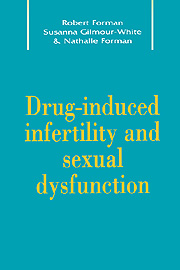5 - Hormone therapy
Published online by Cambridge University Press: 30 March 2010
Summary
Sex hormones
Oestrogens
Combined oral contraceptive pill
In 1993, a National Opinion Poll was carried out on behalf of a pharmaceutical company that manufactures contraceptive pills. This poll surveyed 1000 women in the 16 to 44 year age range. The combined oral contraceptive pill (OCP) was the most popular form of contraception used: 90% of women had used it at some time in their sexual history and 33% of women were current users.
The pill is designed to produce reversible infertility. The oestrogen component inhibits ovulation and the progestogen both balances the oestrogen (oestrogen unopposed by progestogen can induce endometrial cancer) and has contraceptive properties. As the therapeutic effect of the pill is to produce infertility, it is not relevant to discuss this aspect further. However, there have been a few reports linking OCP use to reduced libido. In a 1976 review of psychological effects of pill use, Kane reported that between 10 and 40% of users of OCPs suffered mild to moderate depressive syndromes, many also experiencing loss of libido (Kane, 1976). This figure does seem very high but these studies, which were all performed in the late 1960s and early 1970s, were concerned with hormone formulations that used much higher doses of oestrogen and different progestogens from those in current use. However, even a recent placebo-controlled study using modern triphasic contraception has shown that women using these pills reported significantly decreased sexual interest during the menstrual and post-menstrual phases of the cycle. This effect was unrelated to any influence of the pill on mood (Graham & Sherwin, 1993).
- Type
- Chapter
- Information
- Drug-Induced Infertility and Sexual Dysfunction , pp. 72 - 84Publisher: Cambridge University PressPrint publication year: 1996



